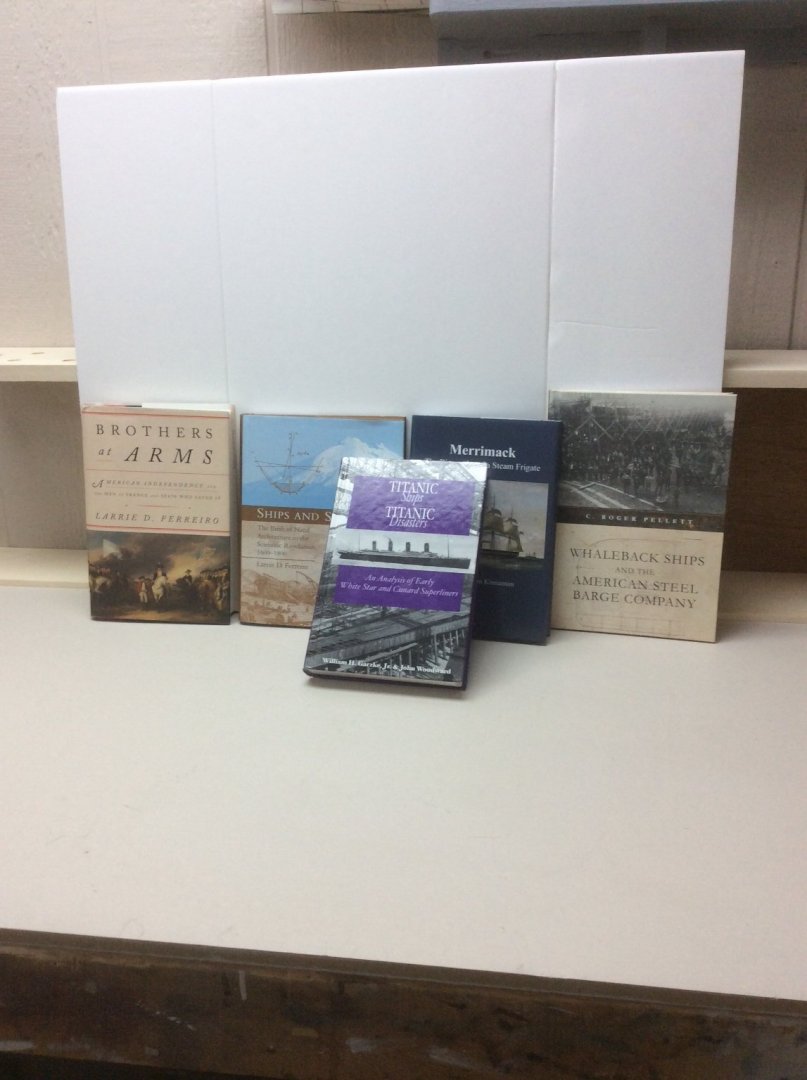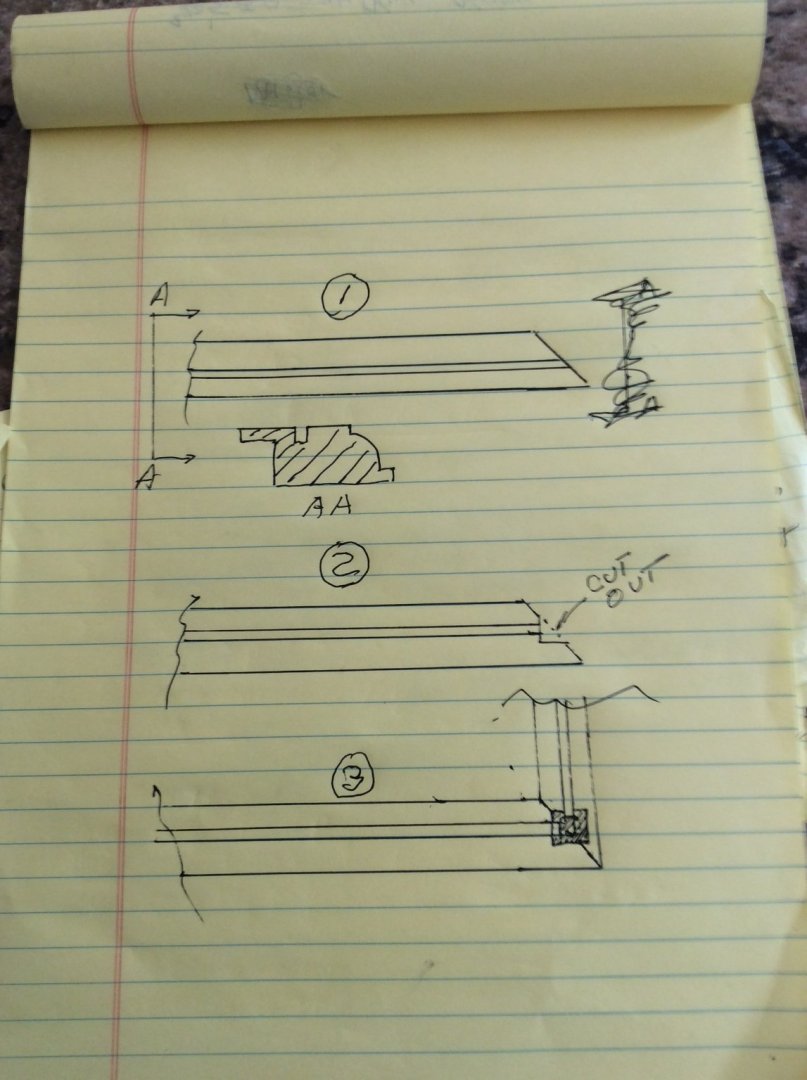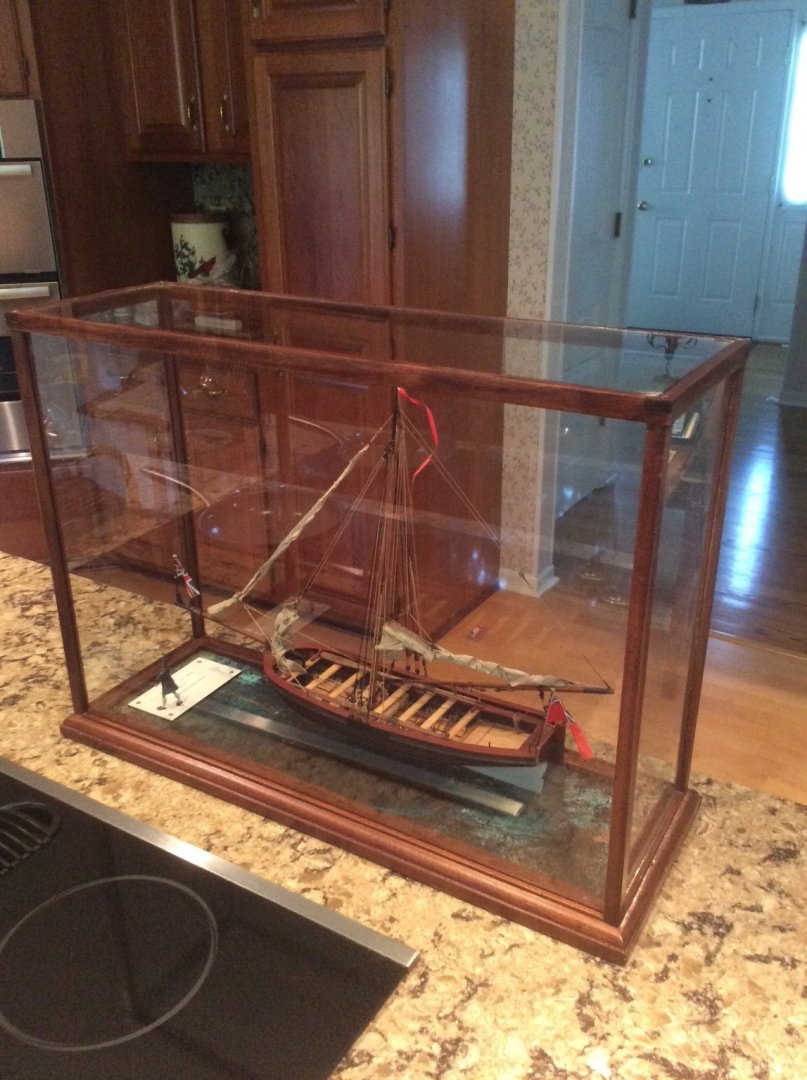
Roger Pellett
NRG Member-
Posts
4,519 -
Joined
-
Last visited
Content Type
Profiles
Forums
Gallery
Events
Everything posted by Roger Pellett
-
Specifications for Mid Nineteenth US Navy launches and cutters are quite specific in requiring that all thwarts be removable to allow nesting of smaller boats. Photos of these boats show that stern sheets and bottom boards were also fitted with removable “boat shaped” inserts to further allow nesting. The ends of the thwarts were reinforced with iron plates and iron pins slipped through drilled holes into metal flanges fastened to the clamps when the thwarts were put in place. For example see: The Kedge Anchor, William Brady, 1849, Article No. 519 Roger
-
An amazing example of miniaturizing the real thing. Well done! Roger
- 55 replies
-
- auguste piccard
- submarine
-
(and 2 more)
Tagged with:
-
Back in the day, Ship model kits were centered on machine carved solid wooden hulls; a technology invented over 100 years earlier to mass produce wooden gun stocks. The model maker finish carved the hull, and added stempost, sternpost, keel, etc. In the hands of a skilled modelmaker excellent and accurate models could be produced from these kits. In the 1970’s-1980’s these kits began to be displaced by European Plank on Bulkhead kits that claimed to allow models “to be built like the real ship,” even though with their widely spaced bulkheads they had more in common with model aircraft. Comparing the two types of kits, it’s easy to see why European kit manufacturers favored their system. It cost them much less to provide and ship strip and sheet stock than large blocks of quality wood. It is also possible that novice model makers found this form of construction less intimidating than finish carving a solid hull, until they began planking, but by that time they had already spent their money. But now the kit manufacturers had another problem. Bending strips of wood around a few widely spaced bulkheads would not necessarily provide a fair (smooth) hull, let alone one that faithfully represented the actual ship. To overcome this problem, they adopted the Double Planking System. By using this system, the builder has an opportunity to fair his hull before adding the second planking layer. Just like the real thing? Hardly! If for some reason I was to build one of these kits, I’d add solid blocks between the bulkheads and properly fair the hull. Then I’d plank the hull with a single layer of quality planking. But if I were going to go to this effort, I’d just rather build a model from scratch. Roger
-
soldering brass cannons
Roger Pellett replied to rich-mar's topic in Metal Work, Soldering and Metal Fittings
Sorry, but your picture is hard to make out. From what I can see it looks silver or grey. Are you sure that it’s brass? If not, there are many metals that can’t be soldered. Roger -
Wayne A great post!, Re: Laurie Ferreiro’s Book They must put something in the water that comes from the drinking fountain of the University of Michigan’s Naval Architecture Department that causes us to write as there are currently a number of published authors who are graduates (Ferreiro and yours truly included). I have never met Mr. Ferreiro but like you enjoyed his Ships and Science. He has recently brought his history of the scientific side of Naval Architecture up to date with a sequel that I have yet to purchase. He has also written an excellent book on the American Revolution that was nominated for a Pulitzer Prize. Titled “Brothers at Arms” it places the Revolution in an international context. I highly recommend it. Current Books written by University of Michigan Naval Architecture Graduates:
-
As an unrepentant thread wanderer I bit my lip when I read the first post above. Since others have uttered the “B” word 😁 I’m now free to add my two cents worth. I have a Miniature table saw (Byrnes) and it’s a beautifully made tool. It can do a great job of precisely cutting small section timbers. The original request was, however, for a saw for “ripping planks and such.” If this means cutting model sized planking from sheet stock, a miniature table saw is a good choice. But, if this means breaking full thickness planks (3/4in) down to scale thickness I would recommend something with more power; either a full sized table saw or bandsaw. A table saw using 8in blades can be used to rip full thickness stock. Then fitted with a hollow ground blade and zero clearance insert can produce model sized planking. Roger
-
Having spent most of my life in or near rural America, my observation is that working farms are messy places- I suppose that when the day’s work is done the farmer does not have time or energy for much landscaping. Vacation visits to Great Britain confirm that working farmers there are not much neater. Another item seen at farms that muck out their barns regularly is a pile of manure waiting to be spread on the fields. Maybe Belgian farmers are different. I don’t know as I haven’t been there. Roger
-
Ras, I also like the PVA glues, of which Titebond is one. I recommend that you use one of the PVA glues for plating your hull. I don’t like the applicator tip on the bottle as when it sits for a while it gums up with dried glue. To solve this problem I bought a cheap squeeze bottle like diners used to use for ketchup and mustard. The top on the bottle screwed onto the Titebond bottle. Roger
-
I have most of the “Two Foot Library” books in my collection, bought when I was much younger. While they are old standbys, their scope is limited pretty much to Eighteenth and Nineteenth British and American Sailing Vessels. As such they would be useful to most kit builders trying to improve the accuracy of their work. The list mostly omits small craft, regional craft, and completely omits engine powered ships. I am a scratch builder that tries to build models of vessels never modeled or at least rarely modeled before. This means that these ships either did not participate in noteworthy historic events, or for which little information is commonly available. This means tracking down information on a project by project basis. Others venturing into scratch building will need to either buy the plan packages available from sellers like Ancre and Seawatch or develop a library for each project as I have done. Roger
-
You gotta wonder how effective that voice tube would have been after the action started?
-
That looks like the stuff that many outlets today pass off as “Mahogany.” Coarse, stringy- nasty stuff. No comparison to the real thing. If you have a wood burning fireplace it might make good kindling. If you can mill your own wood, living in Chicago you should be able to find a real lumberyard that can offer something much better. Roger
-
The reason for the notches used with my system is to secure the uprights. The uprights pass clear thru the mitered base joints to the case bottom. They are easily cut with my bandsaw. For an earlier case, I used short pieces of dowels glued into holes drilled into the base and longitudinally into the uprights. This didn’t provide the same rigidity. Roger
-
I’d like to add my two cents worth to Bob’s excellent post above. Although you have decided to buy a kit, this might be interesting to others wanting to build one from scratch. Tools: At least one right angle picture frame clamp is a must. Also a table saw for ripping stock and cutting grooves. I have a 35+ year old set of Sears molding cutters that are excellent for cutting the decorative edge on the prepared stock. If you are interested in using a set of these i’d be happy to post a photo of my setup. Materials: I personally like American Black Walnut as it is easy to finish and I have a good supply. Although Mahogany is a traditional boatbuilding material, the stuff sold today called Mahogany is nasty stuff. If you can find and are willing to pay for true Honduras Mahogany it is a joy to work with. Teak can make a nice case and is also easy to work with. I find cherry to be hard to finish. Like Bob, I like the thickened epoxy glues. A little poster paint powder can be added to the mix to color it like the wood that you are using. For the last case that I built, I bought glass from our local Ace Hardware. They cut it accurately. Since I don’t live in sunny California,😜 I have not used UV resistant glass. The rough sketch below shows my system. The key is embedding the upright posts into notches cut into the mitred corner joints of the base. When glued with epoxy this results in a solid three dimensional joint. When making these corner joints, I use right angle triangles made from 1/8th thick plywood set into the grooves to ensure that everything is square. Wax the edges of the ply!
-
Airbrush “controls”
Roger Pellett replied to glbarlow's topic in Painting, finishing and weathering products and techniques
If you live in a part of the world that has “Big Box Home Improvement Stores” such as Home Depot, Menards, Lowe’s, Etc, each one will stock a line of store brand air compressors. These come with an air tank, pressure regulator, and moisture trap. The compressor-tank combination is sized to drive the air nailing and air stapling tools that these stores also sell. These small compressors will provide enough clean, dry, air at the desired pressure to operate any airbrush. They often go on sale, particularly at Holiday Time. They can be bought for around $100. I fitted the Connections for my air brush, my air tools and the compressor with quick disconnect fittings. Air brush companies also sell adaptors to connect with the outlets of these compressors. They’re also great for inflating bike tires and the flat on your wife’s car that she ignored. Roger -
Wefalk, I assume that you are referring to the job of scrapping obsolescent Russian Submarines. Here in Duluth, we have several companies that manufacture heavy shears for cutting scrap metal. These shears are boom mounted on the same tracked units used as excavators. The businesses grew out of boom mounted equipment built for the logging industry. In 1990, my wife and I were involved in helping to settle a family that had immigrated from Russia. The husband had had an excellent position in a Russian tractor plant, but jobs in Duluth were scarce. One day he was offered a job by one of the companies that manufactured these shears. They had just received a large contract to supply these for use cutting up Russian Submarines. The job involved supervising final assembly of the machines in Russia. Having just “escaped” with his family he had no interest in returning to Russia. Fortunately, he made a good decision. He went on to have a successful career with another company. Roger
-
It looks like your planking job gave you a nice fair hull- Well Done! I would fill any large nicks and gaps with a sandable filler, one that will completely harden. I would not try to fill the pores in the wood. Then sand thoroughly. Many modelers consider the first coat of primer to be sacrificial. Then prime again. It may take more than one additional sand and prime cycle to get the results that you are looking for. Roger
-
Copper hull plates cut
Roger Pellett replied to Gabri's topic in Metal Work, Soldering and Metal Fittings
A number of years ago I bought a good quality paper cutter, the kind where a lever pivots and shears the paper. It will cut thin copper and brass sheet cleanly. I second Allen’s suggestion about trying to simulate nails in the plates: Don’t! Roger -
I have several spools of linen line that I bought from Model Shipways way back when. The brand is Cuttyhunk and it is nice stuff. I just looked up Cuttyhunk on eBay under the Fishing Supplies category. There are numerous offers. Not cheap!
-
I am not advocating it’s use as suitable for building fine models, but there are occasionally posts on the forum from modelers looking for balsa carving blocks. Today I got an ad from Woodcraft Supply, (woodcraft.com) for balsa carving blocks. I don’t know sizes or prices. I have no connection to the company. Roger
-
I recently found and bought a pin vice like #6 and 7 that you show above. Are the brass inserts intended to be removable so that they can be replaced with custom shaped ones? Having a unique ability to damage finely made tools, I don’t want to muck this one up. Roger
About us
Modelshipworld - Advancing Ship Modeling through Research
SSL Secured
Your security is important for us so this Website is SSL-Secured
NRG Mailing Address
Nautical Research Guild
237 South Lincoln Street
Westmont IL, 60559-1917
Model Ship World ® and the MSW logo are Registered Trademarks, and belong to the Nautical Research Guild (United States Patent and Trademark Office: No. 6,929,264 & No. 6,929,274, registered Dec. 20, 2022)
Helpful Links
About the NRG
If you enjoy building ship models that are historically accurate as well as beautiful, then The Nautical Research Guild (NRG) is just right for you.
The Guild is a non-profit educational organization whose mission is to “Advance Ship Modeling Through Research”. We provide support to our members in their efforts to raise the quality of their model ships.
The Nautical Research Guild has published our world-renowned quarterly magazine, The Nautical Research Journal, since 1955. The pages of the Journal are full of articles by accomplished ship modelers who show you how they create those exquisite details on their models, and by maritime historians who show you the correct details to build. The Journal is available in both print and digital editions. Go to the NRG web site (www.thenrg.org) to download a complimentary digital copy of the Journal. The NRG also publishes plan sets, books and compilations of back issues of the Journal and the former Ships in Scale and Model Ship Builder magazines.






